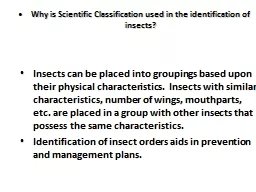

Insects can be placed into groupings based upon their physical characteristics Insects with similar characteristics number of wings mouthparts etc are placed in a group with other insects that possess the same characteristics ID: 909081
Download Presentation The PPT/PDF document "Why is Scientific Classification used in..." is the property of its rightful owner. Permission is granted to download and print the materials on this web site for personal, non-commercial use only, and to display it on your personal computer provided you do not modify the materials and that you retain all copyright notices contained in the materials. By downloading content from our website, you accept the terms of this agreement.
Slide1
Why is Scientific Classification used in the identification of insects?
Insects can be placed into groupings based upon their physical characteristics. Insects with similar characteristics, number of wings, mouthparts, etc. are placed in a group with other insects that possess the same characteristics.
Identification of insect orders aids in prevention and management plans.
Slide2Scientific Classification
Kingdom
Phylum
ClassOrder FamilyGenusSpecies
Insects belong in the Phylum
Arthropoda
. The Phylum
Arthropoda
is characterized by having segmented bodies and jointed appendages.
Slide3Example of Classification of Insects:
Lady
Beetle -
Hippodamia convergens Kingdom – Animalia
Phylum - Arthropoda
Class - Insecta
Order - ColeopteraFamily - CoccinellidaeGenus - Hippodamia. Species - convergens
Slide45 Classes of Arthropods
Class #1-
Hexapoda: Insects, six, jointed appendagesClass #2- Chilopoda- Centipedes, one pair of legs per body segment, multiple body segmentsClass #3- Diplapoda- Millipedes, two pairs of legs per body segment, multiple body segmentsClass #4- Crustacea- Crayfish, five pairs of jointed appendagesClass #5-
Arachnida
- Spiders, four pairs of jointed appendages
Slide5The sixteen orders are:
OrthopteraHemipteraHomoptera
Coleoptera
Lepidoptera
DipteraHymenopteraOdonata
Neuroptera
Thysanura
Isoptera
Siphonaptera
Phthiraptera
Thysanoptera
Dermaptera
Blattodea
Slide6Orthoptera
Includes:
Indian House Crickets
Field Cricket
Short-horned Grasshoppers Katydid (Long-horned Grasshoppers)Mouthparts:
Chewing
Metamorphosis
:
Incomplete Metamorphosis
Damage:
Chewing leaves, Crop grains,
Fun Facts
: Many produce sound through stridulating. Over 20,000 species worldwide.
Slide7Hemiptera – True Bugs
Includes:
Assassin bugs
Kissing bugs
Leaf-footed bug
Lygus
bug
Stink bug
Minute pirate bug
Big-eyed bug
Damsel bug
Mouthparts:
Piercing-Sucking
Metamorphosis
:
Incomplete MetamorphosisFun Facts: All of the true “bugs” are in this order.
Most have a common v shape on their shield.
Slide8Homoptera
Includes:
Cicadas Aphids Armored scales Cottony cushion scale Cochineal scale Leafhoppers Treehoppers
Whiteflies
Mouthparts:
SuckingMetamorphosis: Generally incomplete Fun Facts: Cochineal scales are used in makeup products for the red color.
Slide9Coleoptera
Includes:
Beetles and Weevils
Blister beetle Boll weevil Collops beetle Darkling beetle (Pinacate or Eleodes beetle) Dermestid beetle Dung beetle
Fig beetle
Flea beetle
Lady beetle (Ladybird beetle/ Ladybug) Long-horned beetle (round-headed wood borer) Palo Verde root borer Metallic wood borer (flat-headed borer) White grub (Scarab beetle larva)
10 Striped June beetle
Mouthparts:
Chewing, Weevil- Piercing Sucking
Metamorphosis
:
Complete
Metamophosis
Fun Facts:
Coleoptera means sheath wing.
Slide10Lepidoptera
Includes:
Butterflies and Moths
Bagworm
Two-tailed Swallowtail
Budworm/BollwormPink BollwormGrape-leaf SkeletonizerSalt Marsh Caterpillar
Tomato Hornworm
Sphinx Moth
Monarch
Checkered skipper
Mouthparts:
Chewing – Caterpillars, Siphoning – adult.
Metamorphosis
:
Complete MetamorphosisFun Facts: The largest butterfly is the Birdwings that have 11in wingspans.
Slide11Diptera
Includes:
Flies, Midges, Mosquito
House fly Crane fly Syrphid or hover fly Bee fly Tachinid fly Bot fly Deer fly Mosquito
Gall Midge
Mouthparts: Sponging, Piercing sucking- MosquitoMetamorphosis: Complete Metamorphosis
Facts:
Are common vectors of disease.
Slide12Hymenoptera
Includes:
Bees, Wasps, Ants
Horntail wasp Sawfly Gall wasps Honey bee Leaf-cutter bee Carpenter bee Bumble bee Harvester ant Leaf-cutter ant
Fire ant
Velvet Ant (
mutillid) Paper wasp Ichneumon wasp Thread-waisted wasp
Tarantula hawk (spider wasp)
Mouthparts:
Chewing-Lapping
Metamorphosis
:
Complete
Metamorphosis
Facts: Contain all the social
insects except termites.
Slide13Odonata
Includes:
Dragonfly,
Damselfly Mouthparts: Chewing-Lapping Metamorphosis: Complete MetamorphosisFacts:
Live in the water the first year of their lives.
After leaving the water they only live a month.
Have been around 300 million years.
Slide14Neuroptera
Includes:
Green Lacewing
Antlion
Mouthparts:
Metamorphosis
:
Complete Metamorphosis
Facts:
Both are beneficial insects.
Antlions
create
a sand pit to capture unsuspecting prey.
Slide15Thysanura
Includes:
Silverfish Firebrat
Mouthparts:
Chewing Metamorphosis: Incomplete MetamorphosisFacts:
Like to lay their eggs in books and wall paper because of the paper and glue.
Live 3-5 years
Most primitive of all insects.
Slide16Isoptera
Includes:
Dry-wood termite
Subterranean termite
Mouthparts:
Chewing Mouthparts
Metamorphosis
:
Incomplete Metamorphosis
Facts:
Live for 15 years.
Lay 1 egg every 15 secondsEat wood. Can destroy a house in 2-3 years. Found in every US state except Alaska. Recycle wood in the soil.
Slide17Siphonaptera
Includes:
Cat and dog flea Mouthparts: Piercing SuckingMetamorphosis: Complete MetamorphosisFacts:
Fleas can live 100 days without feeding.
Can jump 100 times their own length. Been around more than 100 million years. Females can consume more than 15 times their body weight daily.
Slide18Phthiraptera
Formally
Anoplura and MallophagaIncludes: Lice
Chewing Louse
Sucking Louse
Mouthparts: Chewing and Piercing-SuckingMetamorphosis:
Complete Metamorphosis
Facts:
Sucking lice feed continuously on lice
Chewing lice feed on hair and feathers of animals and humans.
Wingless. Do not fly or jump
Slide19Blattodea
Includes:
Cockroaches
American CockroachBrown-banded cockroachDesert CockroachTurkish CockroachGerman Cockroach
Mouthparts:
Chewing Mouthparts Metamorphosis: Complete Metamorphosis
Facts:
Typically Live outside
Walk inside. DO NOT live in the water pipes.
Slide20Dermaptera
Includes:
Earwigs
Earwig Mouthparts: Chewing Mouthparts Metamorphosis: Complete MetamorphosisFacts:
Like humid, dark areas.
Release a foul smelling liquid up to 4in away.
Oldest known fossil dates back to Jurassic period.
Slide21Thysanoptera
Includes:
ThripThrip Mouthparts: Rasping-Sucking Mouthparts Metamorphosis: Complete MetamorphosisFacts:
Common Pests on flowers, citrus and onions.
Multiples of this pest are still called Thrip.